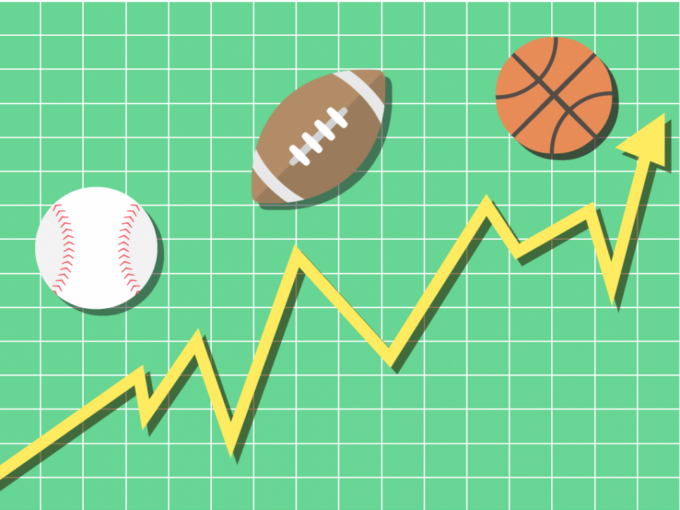Beginner bettors, or those with a lot of experience, but disinclined to reflection, think little about the strategy of the game, any order and logic. Chaos dominates their actions. Today we bet a little, tomorrow a lot, the day after tomorrow again little left over from the previous loss, and a week later we take a loan and go all in to win back. All of this of course leads to tragedy. As our resource aims to foster a culture of betting, the formation of adequate methods that give chances for remote profits, we must speak out on the subject of increasing betting. This is what we will do in this material. Is it worth raising bets at all? If yes, then why do we do it? How to competently increase the size of the amounts set? How not to raise the rate and why? This set of questions will be answered.
Raise or Flat Rates

Source: drbobsports.com
There are two basic approaches to the allocation of the game bank between specific iterations, bets. You can divide the deposit into equal parts and play this fixed amount or percentage. Such rules set equal or independent financial strategies: the flat, the percentage of the bank, the Miller method. Very close to such logic is the “fixed profit” algorithm, where a fixed value is taken as the dirty winnings, and the amount at a particular step depends on the odds. Given that the indicator is taken in a fairly narrow range, it is incorrect to take the local increase in the amount of bets as an increase in the full sense. About the increase in the amount of the move speaks when we are talking about a multiple increase in amounts. Listed independent strategies from that and independent, that the size of the sums of bets do not depend on the results of previous attempts. Not surprisingly, this category of algorithms is considered the safest.
However, such techniques have disadvantages. Firstly, they allow you to make a profit only when the passability is positive. The percentage of winning bets at a distance must be higher than a certain bar, which is set by the average odds. Secondly, the growth rate in such a game is very slow, limited by the same dependence on the percentage of passage. This, of course, does not suit those players who have a very unstable fluctuation rate or want to make quick “icks”, increase their bankroll by 2, 5, 10 or more times. It is these reasons that led to the creation of various progressive financial strategies that involve increasing the stakes.
Below we will look at increasing the amount of the move in two key directions. One of them is commonly referred to as “dogon” and the other as “staircase”. These are common names under which dozens of varieties of strategies are combined. Each group of algorithms is united by a common principle. We will not go into the nuances of each scheme. We have given considerable attention to the parsing of these methods in separate reviews about them. Here we are interested in more global points, in principles. In addition to the ordered rigid algorithms, which involve raising rates, we will touch on two other options. Conditionally the third in our list will be the unauthorized, not formalized rates increase. As can be easily guessed, it is the most dangerous and pernicious type of description.
Raising by Algorithms Such As “Upside”.

Source: bizjournals.com
When a player can not reach a sufficient level of passing on the distance, he resorts to a strategy type of “upside”. Striking representatives of this type of financial algorithms are: Martingale strategy, the Dalamber method, a number of Fibonacci numbers, there are others, less common.
Increase by Strategies of the “Ladder” Type
The second global group of strategies involving controlled raises is the “staircase” and its variants. In contrast to “dogons”, here the increase in the amount of bets takes place not on the downtrend, a series of losses, but on the contrary – on a series of wins.
Limited Raising Bets.

Source: thetrentonline.com
We have described two extreme cases, an increase in the size of bets according to the algorithm and spontaneously. But there is also a third scenario where the size is regulated manually by the player. This is not a spontaneous increase, it is regulated. It’s just that the range is wider than what is usually prescribed in rigid financial strategies. For example, a player bets between 1% and 5% per wager. That is, one step can differ from the other times, up to 5 times in this example. Adjustment of the bet amount is made depending on the type of bet and the player’s confidence in the result. So this methodology is only for experienced bettors who are able to distinguish the conditions by the degree of reliability. Beginners are not recommended to raise bets at all.
They should practice on flat, strictly regulated strategies, like flat with low percentage. If they should raise the stakes, they should do it with the experience and according to the algorithms described above. And only at a certain level of mastery one may switch to a variant system of raising, based on confidence.
For example, a player has considered a bet on soccer, on “both to score – yes”, or on the total more than 2.5. This is a bet with rather complicated conditions. Confidence is average, so the bettor allocates 1-2% of the bank for these bets. Another bet the player has looked at the zero goal handicap or individual total more than 1 goal, and the team he considered to be the hidden favorite in the match. In this case, due to the maximum insured outcome (against the draw or the case of only 1 goal), as well as the maximum confidence he allocates for such a bet 4-5% of the bank. It is also possible to raise this level, but one has to come to this level, to feel this confidence.
It should be noted that anyway there is a ceiling and it is not too high, not in a va-bank as it happens with spontaneous increasing bets. And it is not the desire to win back urgently, not gambling or ephemeral intuition, but experience and understanding of the reliability of the betting conditions that drives it.
Source: BookmakerAdvisor







